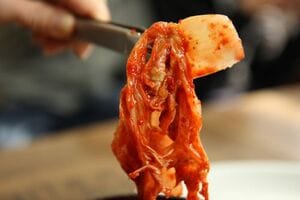Eat it a lot!
written by: 雨果-J-斯马尔
Do I offend anyone when I state: “Korea is kimchi?” Of course, the DaeHan Minguk is much more than that, but the fermented vegetables are the most important. Sometimes I get the feeling that the Korean is busy with nothing else than making sure that there is a healthy portion of this fermented Korean specialty on the table.
Fermented vegetables are healthy!
Kimchi is a traditional Korean dish made of fermented vegetables, usually cabbage, and a variety of seasonings. It is known for its spicy, tangy flavour and is often eaten as a side dish or used as a condiment. Many potential health benefits are associated with eating it, including improved digestion and a boosted immune system. Additionally, it is a good source of vitamins and nutrients, including vitamin C and iron. Overall, incorporating typical Korean vegetables into your diet can be a delicious and nutritious way to improve your health.


Typical Korean staple dish.
There are many different types of this Korean delicacy. It is a traditional dish enjoyed in Korea for centuries. It originate in Korea over 2,000 years ago and has since become an integral part of Korean cuisine. The word “kimchi” comes from the Korean word “chimchae”, which means “vegetable soaked in brine”. Some of the most common types are baechu (made with Napa cabbage), ggakdugi (made with diced radish), and oi sobagi (made with cucumber). Other types may be made with onions, garlic, ginger, and various seasonings. The ingredients used can vary depending on regional preferences and personal taste.
Every region is its own Kimchi.

It is a tradition in Korea to make seasoned cabbage dish together. It is a communal activity, with families and neighbours coming together to prepare large batches of the dish for the winter months.
In recent years it has become popular worldwide as a healthy and flavorful food. It is high in vitamins and nutrients, and the fermentation process gives it probiotic properties. Many people enjoy the spicy staple as a tasty and healthy addition to their diet.
Make the typical Korean vegetables yourself.
Here is a simple recipe for the most common type: baechu.

Ingredients:
- 1 large head of napa cabbage
- 1/4 cup coarse sea salt
- 6 cups water
- 1/2 cup Korean red pepper flakes
- 1/4 cup sugar
- 1/4 cup fish sauce
- 1/4 cup minced garlic
- 1/4 cup minced ginger
- 4 scallions, chopped
Instructions:
- Cut the cabbage into quarters and remove the tough core from each piece. Cut each quarter into 2-inch pieces.
- In a large bowl, combine Mix the cabbage and salt. Let it sit for 1-2 hours to allow the cabbage to release its moisture.
- Rinse the cabbage well under cold water and drain.
- In a separate bowl, combine the water, red pepper flakes, sugar, fish sauce, garlic, ginger, and scallions. Mix well to make the kimchi paste.
- Add the kimchi paste to the cabbage and mix well. Coat each piece of cabbage with the paste.
- Transfer the kimchi to a large jar or crock and press down firmly to remove any air bubbles. Cover it with a lid or plastic wrap and let it sit at room temperature for 1-2 days. The kimchi will ferment.
- After 1-2 days, transfer the jar to the refrigerator and let the kimchi ferment for at least another week before serving.
How to use Kimchi?
 The tradition Korean side dish, is a versatile ingredient to use in a variety of dishes in the kitchen.
The tradition Korean side dish, is a versatile ingredient to use in a variety of dishes in the kitchen.
- Serve it as a side dish with rice and other Korean food. Or use it as a topping for bibimbap (mixed rice with vegetables) or noodles.
- Add it to soups and stews to give them a spicy, flavorful kick. It is a common ingredient in recipes such as kimchi jjigae ( stew) or noodle soup.
- Mix the Korean side dish with other ingredients such as sliced carrots, radishes, and cucumbers. It becomes a refreshing and spicy salad.
- Add it to fried rice with ingredients such as diced bacon, scrambled eggs, and scallions. It becomes a delicious and flavorful meal.
- As a marinade: Use the spicy, tangy flavour of the fermented vegetable as a marinade for meats and vegetables. Mix it with soy sauce, garlic, and honey to make a tasty marinade for grilled or roasted dishes.

Overall, the spicy staple is a versatile ingredient that adds flavour and spice to many dishes in the kitchen. And no! No one should be offended when I say: Korea is kimchi. For me, this is absolutely the truth. It is the smell and taste of the Dae Han Minguk. Best enjoyed with a glass of Soju.
The kimjang. People gather, work together, and help each other while preparing kimchi. Unesco intangible Heritage. read about it
When you like Korean food please follow: 韩国厨房
[embedyt] https://www.youtube.com/watch?v=W87fOBWnpsM[/embedyt]
暂时停止锦鲤出口--疗养公园正在开发中
国际锦鲤出口目前处于暂停状态。与此同时,我们正在为一个 自然驱动的 疗养公园 位于高阳市,融合了锦鲤文化、艺术和静谧的手工艺。 如需更新或合作信息,请随时联系我们。
联系人 Kim Young Soo